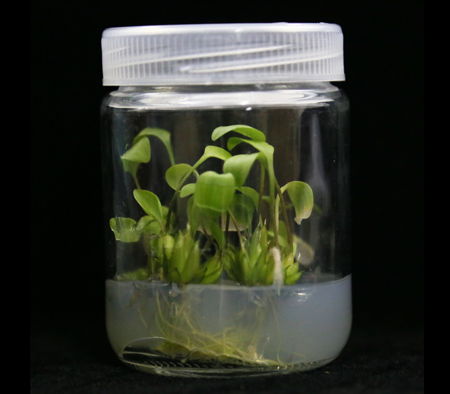

欧洲百合愈伤组织诱导及植株再生体系的建立
作者简介:白克智, 1959年开始在中国科学院植物研究所工作, 先后任助理研究员、研究员, 长期从事植物生长发育及其调控的研究。1986年,其主持的“满江红生物学特性研究”荣获中国科学院科技进步二等奖。曾任《植物生理学报》编委、《植物学报》常务编委、中国植物生长调节剂协会主任等职。
收稿日期: 2017-11-07
录用日期: 2018-02-05
网络出版日期: 2018-02-05
基金资助
中国科学院重点部署项目(No.KFZD-SW-313)和国家重要野生植物种质资源共享平台开放共享后补助经费项目
Callus Induction and Establishment of a Plant Regeneration System with Lilium martagon
Received date: 2017-11-07
Accepted date: 2018-02-05
Online published: 2018-02-05
以欧洲百合(Lilium martagon)无菌苗鳞片为外植体, 探讨不同植物激素组合及光暗培养条件对愈伤组织诱导、增殖和再生不定芽的影响, 进而建立欧洲百合高效再生体系。结果显示, 诱导愈伤组织的最佳培养基为MS+0.2 mg?L-1 TDZ+0.5 mg?L-1 NAA, 诱导率为77.14%。在添加TDZ和NAA组合的培养基中进行继代培养, 愈伤组织极易褐化, 胚性活性下降; 采用添加6-BA和NAA组合的培养基可改善愈伤组织的褐化现象, MS+0.5 mg?L-1 6-BA+0.1 mg?L-1 NAA是愈伤组织增殖的最佳培养基, 增殖指数为2.93, 表明6-BA在愈伤组织状态维持中起关键作用。暗培养条件下愈伤组织的诱导率、增殖指数和芽再生系数最高, 分别可达77.14%、2.93和5.43, 且愈伤组织生长状态较好, 不定芽生根正常。研究建立的欧洲百合高效再生体系对于百合种质资源保存、基因工程育种及在国内的推广应用具有重要意义。

张旭红 , 王頔 , 梁振旭 , 孙美玉 , 张金政 , 石雷 . 欧洲百合愈伤组织诱导及植株再生体系的建立[J]. 植物学报, 2018 , 53(6) : 840 -847 . DOI: 10.11983/CBB17208
We studied the effectiveness of different combinations of plant growth regulators and the light/dark condition on callus induction, proliferation and differentiation of bulb scales in Lilium martagon and established a high-frequency regeneration system. The optimal medium for callus induction was MS+0.2 mg?L-1 TDZ+0.5 mg?L-1 NAA, with embryogenic callus induced from 77.14% bulb scales. For callus proliferation, MS medium containing TDZ and NAA produced a browning appearance with the callus lost embryogenic ability quickly; therefore, 6-BA was applied instead of TDZ. Generation of buds from callus was reduced with 6-BA concentration increasing, which indicates that 6-BA plays a key role in keeping meristematic cells of callus from differentiating. The optimal medium for callus proliferation was MS+0.5 mg?L-1 6-BA+0.1 mg?L-1 NAA, with the proliferation coefficient 2.93. Dark treatment led to the highest callus induction rate, proliferation coefficient and number of buds/callus (77.14%, 2.93 and 5.43, respectively); callus showed good growth and the buds could grow roots and develop complete plants, which suggests that the dark condition is more appropriate for in vitro regeneration than the light condition. The rapid propagation system of L. martagon established in this study offers insights into germplasm protection, genetic transformation and application of L. martagon in China.

| [1] | 陈云凤, 张春荣, 黄霞, 黄学林 (2006). TDZ对植物体细胞胚胎发生的作用. 植物生理学通讯 42, 127-133. |
| [2] | 李晓艳, 陈莉, 辛海波, 义鸣放 (2009). 百合鳞片薄层细胞培养高效再生体系的建立. 华中农业大学学报 28, 351-355. |
| [3] | 李雪艳, 严瑞, 张静, 付麟岚, 段鑫, 王春夏, 孙红梅 (2016). 东方百合Tiger Woods离体快繁技术体系的建立. 沈阳农业大学学报 47, 654-660. |
| [4] | 李莺, 李星, 李生玲, 徐薇 (2013). ‘黄天霸’百合花器官愈伤组织诱导及植株再生. 热带作物学报 34, 1507-1512. |
| [5] | 马怡迪 (2015). 野生百合高效再生体系建立及愈伤组织增殖调控研究. 硕士论文. 杭州: 浙江大学. pp. 28-39. |
| [6] | 孙安妮, 张延龙, 牛立新, 王仙芝, 崔雅静, 王润丰 (2011). 宜昌百合体细胞胚诱导及植株再生. 西北农业学报 20, 142-146. |
| [7] | 孙红梅, 王锦霞, 段鑫, 张静, 李雪艳, 高鹤 (2015). 重瓣东方百合Double surprise离体快繁技术体系的建立. 沈阳农业大学学报 46, 391-397. |
| [8] | 王杰, 刘国锋, 包满珠, 黄莉 (2008). 麝香百合胚性愈伤组织状态的调整与植株再生. 园艺学报 35, 1795-1802. |
| [9] | 吴耿, 付春华, 黄永伟, 李为, 余龙江, 栗茂腾 (2011). 岩溶环境下华南忍冬气孔泌钙及其生物矿化. 植物学报 46, 658-664. |
| [10] | 徐晓峰, 黄学林 (2003). TDZ: 一种有效的植物生长调节剂. 植物学通报 20, 227-237. |
| [11] | 袁素霞, 李佳, 明军, 刘春, 徐雷锋, 袁迎迎 (2015). 百合未授粉子房离体培养胚胎形成及植株再生. 植物学报 50, 378-387. |
| [12] | 翟彦, 张宗勤, 贾敏, 王岩, 宋西德, 周雷 (2011). 百合体细胞胚胎发生和植株再生. 西北植物学报 31, 834-841. |
| [13] | 张翔宇, 陈杰, 吉云, 严显进, 王彩云, 阮培均, 王永 (2016). 淡黄花百合珠芽诱导脱分化的研究. 江苏农业科学 44, 58-61. |
| [14] | 张艺萍, 吴丽芳, 吴学尉, 崔光芬, 丁丁, 王继华 (2008). 东方百合胚性愈伤组织诱导和植株再生研究. 江西农业学报 20, 33-36, 39. |
| [15] | Bakhshaie M, Babalar M, Mirmasoumi M, Khalighi A (2010). Somatic embryogenesis and plant regeneration ofLilium ledebourii (Baker) Boiss, an endangered species. Plant Cell Tiss Org 102, 229-235. |
| [16] | Feldmaier C, McRae J (1982). Lilien. Stuttgart: Verlag Eugen Ulmer. |
| [17] | Kedra M, Bach A (2005). Morphogenesis of Lilium martagon L. explants in callus culture. Acta Biol Cracov Bot 47, 65-73. |
| [18] | Khosravi S, Azghandi AV, Mojtahedi N, Haddad R (2007). In vitro propagation of Lilium longiflorum var. Ceb-Dazzle through direct somatic embryogenesis. Pak J Biol Sci 10, 2517-2521. |
| [19] | Mori S, Adachi Y, Horimoto S, Suzuki S, Nakano M (2005). Callus formation and plant regeneration in various Lilium species and cultivars. In Vitro Cell Dev-Pl 41, 783-788. |
| [20] | Qi YY, Du LJ, Quan YH, Tian FF, Liu YL, Wang YJ (2014). Agrobacterium-mediated transformation of embryogenic cell suspension cultures and plant regeneration in Lilium tenuifolium Oriental × trumpet ‘Robina’. Acta Physiol Plant 36, 2047-2057. |
| [21] | Synge PM (1980). Lilies. London: B. T. Batsford. pp. 34-38. |
| [22] | Tang YP, Liu XQ, Gituru RW, Chen LQ (2010). Callus induction and plant regeneration from in vitro cultured lea- ves, petioles and scales of Lilium leucanthum(Baker) Bak- er. Biotechnol Biotec Eq 24, 2071-2076. |
/
| 〈 |
|
〉 |